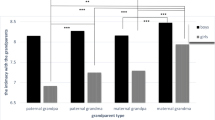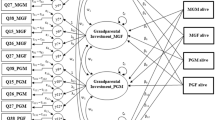Abstract
Many studies in Western societies show a pattern of discriminative grandparental investment as follows: maternal grandmothers (MGMs) > maternal grandfathers (MGFs) > paternal grandmothers (PGMs) > paternal grandfathers (PGFs). This pattern is in line with the expectation from evolutionary reasoning. Yet whether or not this pattern applies in China is in question. The present study was based on a questionnaire survey at a university in Central China (N = 1,195). Results show that (1) when grandparent–grandchild residential distance during grandchildren’s childhood is controlled, in the case of grandsons and granddaughters as a whole and granddaughters only, both grandparental caregiving and grandchildren’s emotional closeness to grandparents display a rank order of MGM > MGF > PGM > PGF, but in the case of grandsons only, this order is not statistically significant. (2) There are stable relationships between grandparental caregiving/grandchildren’s emotional closeness and residential distance/similarity in appearance. (3) The effects of residential distance on either PGFs’ or PGMs’ caregiving exceed those on either MGFs’ or MGMs’. (4) The PGF and PGM prefer grandsons to granddaughters in their caregiving, whereas the MGF and MGM do not have a sex preference, and (5) the fact that the PGF and PGM invest more in grandsons than in granddaughters does not depend on grandsons’ duration of living in a rural area. Our results suggest that (1) in general, the Chinese display a pattern of differential grandparental investment predicted by an evolutionary perspective, (2) the evolutionary perspective that combines the two factors of paternal uncertainty and sex-specific reproductive strategies is applicable to grandparental investment in China, and (3) the traditional son-preference culture also plays some role in affecting grandparental investment in China, though the roles of culture and urban–rural cultural difference should not be exaggerated.








Similar content being viewed by others
Data Availability
All data are available online via the Open Science Framework: https://osf.io/hjuex/?view_only=280ac69254114d7faad7b8ecac1008e7.
References
Bishop, D. I., Meyer, B. C., Schmidt, T. M., & Gray, B. R. (2009). Differential investment behavior between grandparents and grandchildren: The role of paternity uncertainty. Evolutionary Psychology, 7(1), 66–77. https://doi.org/10.1177/147470490900700109
Breen, R. (2004). Social mobility in Europe. Oxford University Press. https://doi.org/10.1093/0199258457.001.0001
Chrastil, E. R., Getz, W. M., Euler, H. A., & Starks, P. T. (2006). Paternity uncertainty overrides sex chromosome selection for preferential grandparenting. Evolution and Human Behavior, 27(3), 206–223. https://doi.org/10.1016/j.evolhumbehav.2005.09.002
Clark, G. (2014). The son also rises: Surnames and the history of social mobility. Princeton University Press. https://doi.org/10.1515/9781400851096-001
Coall, D. A., & Hertwig, R. (2010). Grandparental investment: Past, present, and future. Behavioral and Brain Science, 33(1), 1–19. https://doi.org/10.1017/S0140525X09991105
Daly, M., & Perry, G. (2017). Matrilateral bias in human grandmothering. Frontiers in Sociology, 2, 11. https://doi.org/10.3389/fsoc.2017.00011
Daly, M., & Perry, G. (2019). Grandmaternal childcare and kinship laterality. Is rural Greece exceptional? Evolution and Human Behavior, 40(4), 385–394. https://doi.org/10.1016/j.evolhumbehav.2019.04.004
Danielsbacka, M., & Tanskanen, A. O. (2012). Adolescent grandchildren’s perceptions of grandparents’ involvement in UK: An interpretation from life course and evolutionary theory perspective. European Journal of Ageing, 9(4), 329–341. https://doi.org/10.1007/s10433-012-0240-x
Danielsbacka, M., & Tanskanen, A. O. (2021). Grandparents and grandchildren. In T. K. Shackelford, & V. A. Weekes-Shackelford (Eds.), Encyclopaedia of Evolutionary Psychological Science (pp. 3523–3528). Springer. https://doi.org/10.1007/978-3-319-19650-3_1499
Danielsbacka, M., Tanskanen, A. O., Jokela, M., & Rotkirch, A. (2011). Grandparental child care in Europe: Evidence for preferential investment in more certain kin. Evolutionary Psycholology, 9(1), 3–24. https://doi.org/10.1177/147470491100900102
Euler, H. A., & Weitzel, B. (1996). Discriminative grandparental solicitude as reproductive strategy. Human Nature, 7(1), 39–59. https://doi.org/10.1007/bf02733489
Euler, H. A., & Michalski, R. L. (2011). Grandparental and extended kin relationships. In C. A. Salmon & T. K. Shackelford (Eds.), The Oxford handbook of evolutionary family psychology (pp. 230–255). Oxford University Press. https://doi.org/10.1093/oxfordhb/9780195396690.013.0012
Ferguson, C. J. (2009). An effect size primer: A guide for clinicians and researchers. Professional Psychology: Research and Practice, 40(5), 532–538. https://doi.org/10.1037/a0015808
Fletcher, D., MacKenzie, D., & Villouta, E. (2005). Modelling skewed data with many zeros: A simple approach combining ordinary and logistic regression. Environmental and Ecological Statistics, 12, 45–54. https://doi.org/10.1007/s10651-005-6817-1
Garamszegi, L. Z. (2006). Comparing effect sizes across variables: Generalization without the need for Bonferroni correction. Behavioral Ecology, 17(4), 682–687. https://doi.org/10.1093/beheco/ark005
Gong, H., Leigh, A., & Meng, X. (2012). Intergenerational income mobility in urban China. Review of Income and Wealth, 58(3), 481–503. https://doi.org/10.1111/j.1475-4991.2012.00495.x
Gruijters, R. J., & Ermisch, J. (2019). Matrilocal, patrilocal or neolocal? Intergenerational proximity of married couples in China. Journal of Marriage and Famamily, 81(3), 549–566. https://doi.org/10.1111/jomf.12538
Gupta, M. D., Zhenghua, J., Bohua, L., Zhenming, X., Chung, W., & Hwa-Ok, B. (2003). Why is son preference so persistent in East and South Asia? A cross-country study of China, India and the Republic of Korea. Journal of Develpement Studies, 40(2), 153–187. https://doi.org/10.1596/1813-9450-2942
Hamilton, W. D. (1964). The genetical evolution of social behaviour. I & II. Journal of Theoretical Biology, 7, 1–52. https://doi.org/10.1016/0022-5193(64)90039-6
Harris, M. (1991). Cultural anthropology. HarperCollins.
Helle, S., Tanskanen, A. O., Pettay, J. E., & Danielsbacka, M. (2022). The interplay of grandparental investment according to the survival status of other grandparent types. Scientific Reports, 12, 14390. https://doi.org/10.1038/s41598-022-18693-9
Kaptijn, R., Thomese, F., Liefbroer, A. C., & Silverstein, M. (2013). Testing evolutionary theories of discriminative grandparental investment. Journal of Biosocial Science, 45(3), 289–310. https://doi.org/10.1017/s0021932012000612
Kirchengast, S., & Putz, B. (2016). Discriminative grandparental investment: The impact of grandchild’s gender and sociodemographic parameters. Anthropological Review, 79(2), 151–167. https://doi.org/10.1515/anre-2016-0012
Laham, S. M., Gonsalkorale, K., & von Hippel, W. (2005). Darwinian grandparenting: Preferential investment in more certain kin. Personality and Social Psychology Bulletin, 31(1), 63–72. https://doi.org/10.1177/0146167204271318
Li, J., & Cooney, R. S. (1993). Son preference and the one child policy in China: 1979–1988. Population Research and Policy Review, 12(3), 277–296. https://doi.org/10.1007/bf01074389
Lieberman, D., Tooby, J., & Cosmides, L. (2007). The architecture of human kin detection. Nature, 445, 727–731. https://doi.org/10.1038/nature05510
Menard, S. W. (2002). Applied logistic regression analysis. Sage. https://doi.org/10.4135/9781412983433
Michalski, R. L., & Shackelford, T. K. (2005). Grandparental investment as a function of relational uncertainty and emotional closeness with parents. Human Nature, 16(3), 293–305. https://doi.org/10.1007/s12110-005-1012-5
Moran, M. D. (2003). Arguments for rejecting the sequential bonferroni in ecological studies. Oikos, 100(2), 403–405. https://doi.org/10.1034/j.1600-0706.2003.12010.x
Murphy, R., Tao, R., & Lu, X. (2011). Son preference in rural China: Patrilineal families and socioeconomic change. Population and Development Review, 37(4), 665–690. https://doi.org/10.1111/j.1728-4457.2011.00452.x
Nakagawa, S. (2004). A farewell to Bonferroni: The problems of low statistical power and publication bias. Behavioral Ecology, 15(6), 1044–1045. https://doi.org/10.1093/beheco/arh107
Pashos, A. (2000). Does paternal uncertainty explain discriminative grandparental solicitude? A cross-cultural study in Greece and Germany. Evolution and Human Behavior, 21(2), 97–109. https://doi.org/10.1016/s1090-5138(99)00030-6
Pashos, A., & McBurney, D. H. (2008). Kin relationships and the caregiving biases of grandparents, aunts, and uncles. A two-generational questionnaire study. Human Nature, 19(3), 311–330. https://doi.org/10.1007/s12110-008-9046-0
Pollet, T. V., Nettle, D., & Nelissen, M. (2006). Contact frequencies between grandparents and grandchildren in a modern society: Estimates of the impact of paternity uncertainty. Journal of Cultural and Evolutionary Psychology, 4(3–4), 203–213. https://doi.org/10.1556/jcep.4.2006.3-4.1
Pollet, T. V., Nettle, D., & Nelissen, M. (2007). Maternal grandmothers do go the extra mile: Factoring distance and lineage into differential contact with grandchildren. Evolutionary Psychology, 5(4), 832–843. https://doi.org/10.1177/147470490700500412
Rice, W. R., Gavrilets, S., & Friberg, U. (2010). The evolution of sex specific grandparental harm. Proceedings of the Royal Society B: Biological Sciences, 277(1694), 2727–2735. https://doi.org/10.1098/rspb.2010.0409
Richerson, P. J., & Boyd, R. (2005). Not by genes alone: How culture transform human evolution. The University of Chicago Press.
Salmon, C. A. (1999). On the impact of sex and birth order on contact with kin. Human Nature, 10(2), 183–197. https://doi.org/10.1007/s12110-999-1014-9
Schwarz, S., Pashos, A., & Euler, H. A. (2021). Grandparental investment. In T. K. Shackelford, & V. A. Weekes-Shackelford (Eds.), Encyclopaedia of Evolutionary Psychological Science (pp. 3503–3511). Springer. https://doi.org/10.1007/978-3-319-19650-3_1182
Smith, M. S. (1991). An evolutionary perspective on grandparent–grandchild relationships. In P. K. Smith (Ed.), The psychology of grandparenthood. An international perspective (pp. 157–176). Routledge. https://doi.org/10.4324/9780203359174-20
Tanskanen, A. O., Rotkirch, A., & Danielsbacka, M. (2011). Do grandparents favor granddaughters? Biased grandparental investment in UK. Evolution and Human Behavior, 32(6), 407–415. https://doi.org/10.1016/j.evolhumbehav.2011.02.001
Tooby, J., & Cosmides, L. (1992). The psychological foundations of culture. In J. H. Barkow, L. Cosmides, & J. Tooby (Eds.), The adapted mind: Evolutionary psychology and the generation of culture (pp. 19–136). Oxford University Press.
Yang, Y. Z. (2022). The primary task of urbanization in a new stage of modernization in China: Citizenization of peasants and urbanization of small towns. Reformation and Strategy, 38(5), 1–11. https://doi.org/10.16331/j.cnki.issn1002-736x.2022.05.009. (in Chinese).
Yang, B. F., & Hou, Y. B. (2017). Asymmetry of kin altruism: An empirical study of grandparent investment in grandchildren from an evolutionary perspective. Journal of Gansu Normal College, 22(1), 35–40. https://doi.org/10.3969/j.issn.1008-9020.2017.01.008. (in Chinese).
Zeng, Z., & Xie, Y. (2014). The effects of grandparents on children’s schooling: Evidence from rural China. Demography, 51(2), 599–617. https://doi.org/10.1007/s13524-013-0275-4
Zhao, M., Yang, F., & Zhang, Y. (2020). The power of culture: The gendered impact of family structures and living arrangements on social networks of Chinese older adults. Ageing and Society, 42(3), 657–680. https://doi.org/10.1017/S0144686X20001087
Acknowledgements
We thank Yikun Gan and Guopeng Ni for assistance in data collection, and Lianfei Zhao for helpful comments on statistical analyses.
Author information
Authors and Affiliations
Corresponding author
Ethics declarations
Ethics Approval
Ethics approval for this study was granted by the Ethics Committee of the School of Sociology and Social Work, Central China Normal University (#2021-001).
Conflict of Interest
None.
Additional information
Publisher’s Note
Springer Nature remains neutral with regard to jurisdictional claims in published maps and institutional affiliations.
Supplementary Information
Below is the link to the electronic supplementary material.
ESM 1
(DOCX 28.9 KB)
Rights and permissions
Springer Nature or its licensor (e.g. a society or other partner) holds exclusive rights to this article under a publishing agreement with the author(s) or other rightsholder(s); author self-archiving of the accepted manuscript version of this article is solely governed by the terms of such publishing agreement and applicable law.
About this article
Cite this article
Luo, L., Zuo, Y. & Xiong, X. Discriminative Grandparental Investment in China. Hum Nat 35, 21–42 (2024). https://doi.org/10.1007/s12110-024-09467-5
Accepted:
Published:
Issue Date:
DOI: https://doi.org/10.1007/s12110-024-09467-5




